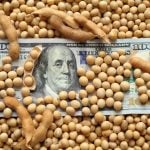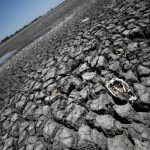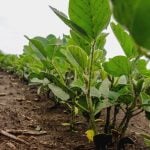Reading Time: 2 minutes A new voluntary program spearheaded by Canada’s soybean value-chain group is expected to help Canadian soy growers seeking a sustainability mark for their goods. Soy Canada on March 28 announced the rollout of Sustainable Canadian Soy, a program it said will be available for the 2023 growing season. Exporters and handlers who supply customers that […] Read more

Sustainable soybean program underway
Food-grade, IP soy growers showing interest in verification, Soy Canada says

Soy complex crushed by selloffs
Reading Time: 2 minutes While canola had undergone another week of sharp losses before bouncing back with a double-digit gain on March 23, the Chicago soy complex also had a week to forget. The May soybean contract fell to US$14.1950 per bushel at the end of March 23 after a one-day, 29-cent drop. It was the ninth negative session […] Read more

China to buy more homegrown soybeans for reserves
State-owned firms urged to prioritize domestic soy
Reading Time: < 1 minute Beijing | Reuters — China will step up buying of domestic soybeans by state reserves to encourage farmers to keep planting the crop, the agriculture ministry said on Thursday, as Beijing continues to push for greater self-sufficiency in oilseed. China started to increase soybean planting a year ago amid worries about its heavy reliance on […] Read more

Argentina soybeans go from ‘worse to worser,’ expert says
Heatwave now crisping early-planted crops
Reading Time: 2 minutes MarketsFarm — Extreme heat and drought throughout most of Argentina have taken a huge toll on that country’s soybean crop. Dr. Michael Cordonnier of Soybean and Corn Advisor said the forthcoming soybean harvest is now likely to produce 25 million to 30 million tonnes, a far cry from the 40 million to 45 million tonnes […] Read more

Canola crush of 2022 smallest in five years
Meanwhile, soybean crush rose on the year
Reading Time: 2 minutes MarketsFarm — Statistics Canada (StatCan) reported that 2022 had the smallest domestic canola crush for a calendar year since 2017. As well, 2022 marked the smallest canola oil production in five years and the least amount of canola meal produced in four years. The sharp reduction of canola being crushed was due to the 2021 […] Read more

Argentina soybean crop smaller than expected, USDA attaché says
Reading Time: < 1 minute MarketsFarm — Argentina’s 2022-23 soybean crop is likely much smaller than official projections as high temperatures and a lack of moisture cut into yields, according to an update from the U.S. Department of Agriculture’s Buenos Aires attaché. The USDA post from the South American country pegged the soybean crop at only 36 million tonnes, which […] Read more

Imperial Oil clears Edmonton renewable diesel plant for construction
Quick decision motivated in part by need for feedstocks such as canola oil, company says
Reading Time: 2 minutes Reuters — Imperial Oil on Thursday announced approval for an investment of $720 million to build Canada’s largest renewable diesel facility at its Strathcona refinery near Edmonton. The Calgary-based company said the facility will produce 20,000 barrels per day of renewable diesel and is expected to start production in 2025. Imperial expects regulatory approval for […] Read more

Worst drought in decades sees Argentina exchange slash soy, corn forecasts
Reading Time: 2 minutes Buenos Aires | Reuters — Argentina’s Rosario Grains exchange sharply cut its forecast for the 2022-23 soybean harvest to 37 million tonnes from a previous forecast of 49 million, it said on Wednesday, as the country faces its worst drought in 60 years. The exchange also slashed its 2022-23 corn harvest estimate to around 45 […] Read more

Pulse weekly outlook: 2022 a ‘good year’ for Manitoba pulses, soy
Reading Time: 2 minutes MarketsFarm — Despite a rough start to southern Manitoba’s growing season, Manitoba Pulse and Soybean Growers executive director Daryl Domitruk was content with how 2022 came to pass. “For pulses and soybeans, it was generally a good year as a result of some very good yields in soybeans and some quite good yields in dry […] Read more

CBOT weekly outlook: Soy futures find support, but upside limited
Corn activity mainly bearish
Reading Time: < 1 minute MarketsFarm — Solid export demand, a short squeeze by fund traders and production uncertainty in South America have all propped up Chicago soybean futures over the past week, with more gains possible ahead of the year-end before correcting lower, according to an analyst. With the South American harvest still some time away, “you might have […] Read more


